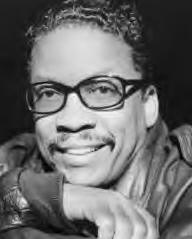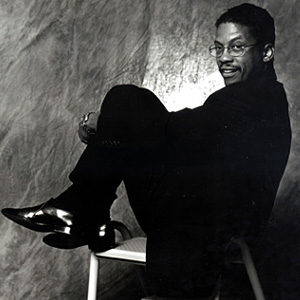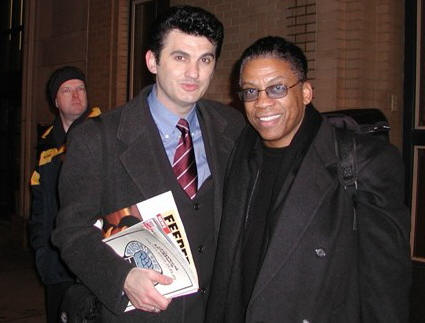

PopEntertainment.com >
Feature
Interviews - Music >
Features Interviews F to J
> Herbie Hancock
 Herbie Hancock
Herbie Hancock
New Directions
by Zoran Misetic
Copyright ©
2005 PopEntertainment.com. All rights reserved.
Posted: February 6, 2005.
Herbie Hancock is a true
icon of modern music. His explorations of melody have transcended limitations and
genres, and at the same time he has maintained an unmistakable voice.
Hancock’s success at expanding the possibilities of melodious thought has
placed him in the annals of this century’s visionaries.
Born into a musical family in Chicago on April 12, 1940, Herbie Hancock
earned his college degree in engineering at Grinnell. He
always had a gift for composition, so despite his degree
music would become his life’s work.
Legendary jazzman Donald Byrd who brought him to New York in January of 1960 and
introduced him to Blue Note Records. Byrd also prodded
Hancock to show Mongo Santamaria his composition
“Watermelon Man” on a band break one night, leading to
Hancock’s first top ten record as a composer.
Hancock began recording for Blue Note as a band leader in May of 1962.
Even from the beginning of his career, his
records clearly chart his development and his varied musical interests.
After impressing with his own work, Hancock was part of the legendary
Miles Davis Quintet for most of the sixties.
Many years later this jazz genius is still finding himself.
Again, he is involved in
dealing with the inventive way of delivering jazz sound, working on
the extremely brave and challenging musical project; Directions In Music.
In
2002, Verve Records released Directions In Music: Celebrating John
Coltrane and Miles Davis. This project was a collaboration between
pianist Herbie Hancock, saxophonist Michael Brecker and trumpeter Roy
Hargrove. The live recording won two Grammys in 2003.
The follow-up program, Directions in Music: Our
Times, is focusing on
and exploring the themes of contemporary composers
such as Wayne Shorter, Hancock, McCoy Tyner, Chick Corea, Jaco Pastorius,
Stevie Wonder and the late Ray Charles.
The point is, just like other greats of jazz, the players in
Direction In Music
don’t stop experimenting. That’s
the name of the game when comes to genius of Herbie Hancock.
 How
did music become your life?
How
did music become your life?
Well… Not really my life, but instead of that I should say,
a good part of my
life. Fact is that I played piano and performed, as a young kid, a Mozart
piano concerto with the Chicago Symphony Orchestra . Don’t forget I was only
eleven-years-old and to
be on the stage at that age had tremendous impact on me. Basically love for
classical music and performing as a kid on the big stage probably led
toward this decision, which meant that music is going to be my big love but
also my profession.
Yeah, but when did you really get
gripped by jazz
?
Oh, my God, that was in my high school days. That’s when I started to play
jazz and at that time, I was very much influenced by Oscar Peterson and Bill
Evans. But also I know at that time that jazz music can and should have full
freedom to sound different… more inventive and confusing at same time.
When I started to play jazz, I found myself dealing with interest which was
directly pointed toward electronic science. I got double major in music and
electrical engineering. Somehow, don’t ask me how, many years later that
helped me to create my own sound, my own approach to jazz music.
Did
you find New York City to be crucial for dramatic
development of your jazz career?
No
doubt. It was crucial for my jazz development. Well, I was helped by Donald
Byrd to basically experience that all beauty of the NYC jazz scene. He gave
to me that initial kick to move forward. First he asked me to join to his
group and after that he introduced me to Alfred [Lion]
from Blue Note Records. In the beginning I was doing, more or less, session
work with guys like Phil Woods and Oliver Nelson, but after probably year and
half or let’s say two years, I signed to the Blue Note Records as a solo
artist.
That was time of your Takin’ Off album and you really “took off
“with that album.
That’s correct. I mean, “Watermelon Man” from that album became instant hit
at jazz and R&B radio and that gave me real recognition in the jazz
community. That was one of the reasons why Miles showed interest in me.
Are
you talking about period when you joined to his Quintet?
Yes. That’s exactly what I meant. Same year I had my solo album out and I
got invited by Miles to join to Miles Davis Quintet. 1963, was definitely
good year for me. Brought to me tremendous experience and let’s face it,
money.
How
long did you stay with Miles Davis?
I
spent five years, at least, working with Miles.
Together, we recorded ESP, Nefertiti, Sorcerer --
and I can tell you; each of these albums instantly became jazz classics.
Hey, we had Wayne Shorter playing tenor sax, Ron [Carter] on bass, Tony
Williams played drums. That was great band we had.
 But
after these five years you still didn’t break loose completely from Miles
Davis?
But
after these five years you still didn’t break loose completely from Miles
Davis?
That’s true. We continued to work together and he invited me to take part on
his crucial recordings such as In A Silent Way and Bitches Brew. Again,
Miles was very instrumental in my jazz career. He was free spirit and he
basically allowed me to go ahead experimental approach to jazz sound.
You
had so many hit records; either your solo records or records that you
recorded with other musicians.
How did you react in 1994 when British hip hop group called Us3 sampled your
classic “Cantaloupe Island” for a track called “Cantaloop
(Flip Fantasia)”?
I
was pleased with the way this band took a spin on “Cantaloupe Island.” At
same time, I was also positively surprised that
their version became a huge international hit. I can tell you, these guys
made lots of the money for Blue Note. It was interesting period in my life
because sometimes in my concerts
the public expected from me to play that
version instead of my original. (laughs)
Do you have high expectations from your new project
Directions in
Music: Our Times?
I
always have high expectations when comes to my approach of shaping jazz
sound. Either live shows or studio recordings, I am always expecting from
myself to give the maximum. On this particular project, I can tell you that I
get great satisfaction from the fact that I am working with talented
musicians who are taking this project down it’s own compositional path. It’s
really good stuff.
The night was cold and short, but
the warm conversation with Herbie Hancock
explained, at least to me, that it’s possible to still
have great interest,
love and desire for something that you
have done for the last
fifty years. Or, as another
musical legend may have put it, Herbie Be Good.
Email
us Let us know what you
think.
Features
Return to the features page
